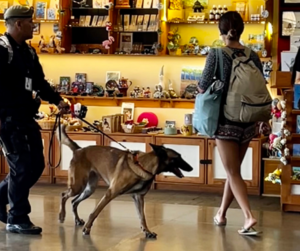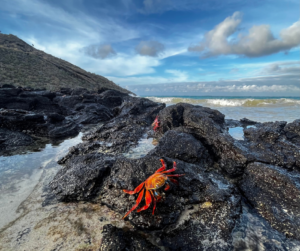Michael Baugh CDBC CPDT-KSA
On about the 5th day of our trip it occurred to me that The Galápagos Islands are one of the few places on earth where everything is still as it should be. There are very few humans. We fish there, but not too much. Birds and large mammals, like the sea lions, are mostly safe from us. We haven’t crowded the animals out or paved everything over. There are a few towns and two small airports. There are small ports and motorized boats. Still, in most ways the animal inhabitants of The Galápagos live as they have for hundreds of years.
What happens when animals live with relatively few pressures from human beings? This is my opinion as a matter of experience. They thrive. This appears in their physical and reproductive health. It also shows in their behavioral health. Because of strict conservation laws, humans are not allowed to hunt or harass animals on the islands. As a result, many are very trusting of us – friendly, in fact. Curious juvenile sea lions routinely approached us on the beach and in the water. Penguins swam up to us and around us, sometimes within inches. Iguanas tolerated our clumsy trodding over them. Birds flew and landed nearby. Giant tortoises plodded along with nary a notice. These are animals under absolutely no pressure from humans. I daresay they are better for it – happier.
 It got me thinking about our dogs. The hard truth is we put our dogs under a lot of pressure. Even the Belgian Malinois at The Galápagos airport on Baltra is under pressure. Say on a leash. Stay in a crate. Climb the luggage and sniff for contraband. Meanwhile back in Houston we insist our dogs answer our every command. Stay alone for hours on end. Move at our pace on walks. Meet who we want them to meet when we want it, including other dogs. All the while remain friendly. Never express an emotion unless it’s one of the ones we like. Behave this way in public, in crowds, wearing a harness and a leash and silly clothes.
It got me thinking about our dogs. The hard truth is we put our dogs under a lot of pressure. Even the Belgian Malinois at The Galápagos airport on Baltra is under pressure. Say on a leash. Stay in a crate. Climb the luggage and sniff for contraband. Meanwhile back in Houston we insist our dogs answer our every command. Stay alone for hours on end. Move at our pace on walks. Meet who we want them to meet when we want it, including other dogs. All the while remain friendly. Never express an emotion unless it’s one of the ones we like. Behave this way in public, in crowds, wearing a harness and a leash and silly clothes.
What if we just let our dogs be dogs? Would that be enough for us? Aren’t they already enough? What if our influence on them was light and kind? What if they got a fraction of the empathy and respect we were required to show the sea lions on the beaches of The Galápagos? Our dogs are noble animals. They are not toys. They are not Disney characters. They’ve evolved with us. They are uniquely suited to live with us. But, our life with them is not all about us. This isn’t all about us.
Human beings, Homo Sapiens, have walked the earth for about 300-thousand years. Only in the past 500 or so years did we really start to spread. Whalers stumbled upon The Galápagos in the early 1500’s. The industrial revolution started just 200 years ago. Two hundred years is very recent compared to 300-thousand. I’ve often said to clients that we humans have already won the evolutionary race. We inhabit every bit of the earth. For better or worse, we’ve won.
 I stood on a beach no one had walked on since the last high tide. I could see stingrays and eagle rays in the surf. Bright orange crabs clung to the lava rocks. A green sea turtle crawled out of the water. Giant frigate birds, broad-winged but barely 2-pounds in weight, floated above. This is where everything is still as it should be, I thought. It wasn’t that long ago that the whole planet was like this, 400 years ago, 500. What happened? When did we decide it was all ours and only ours?
I stood on a beach no one had walked on since the last high tide. I could see stingrays and eagle rays in the surf. Bright orange crabs clung to the lava rocks. A green sea turtle crawled out of the water. Giant frigate birds, broad-winged but barely 2-pounds in weight, floated above. This is where everything is still as it should be, I thought. It wasn’t that long ago that the whole planet was like this, 400 years ago, 500. What happened? When did we decide it was all ours and only ours?
For many of us, our dogs are our only real connection to the natural world. That’s a lot of responsibility for one species. It’s even more responsibility for us. I’m in the business of helping people teach their dogs. But I wonder. What could we learn from our dogs, or from the squirrel, or the cardinal, or the possum, those fragments of the wild that remain? What could they teach us about ourselves?
Michael Baugh teaches dog training in Houston, TX. He specializes in behavior related to fear including aggressive behavior.
